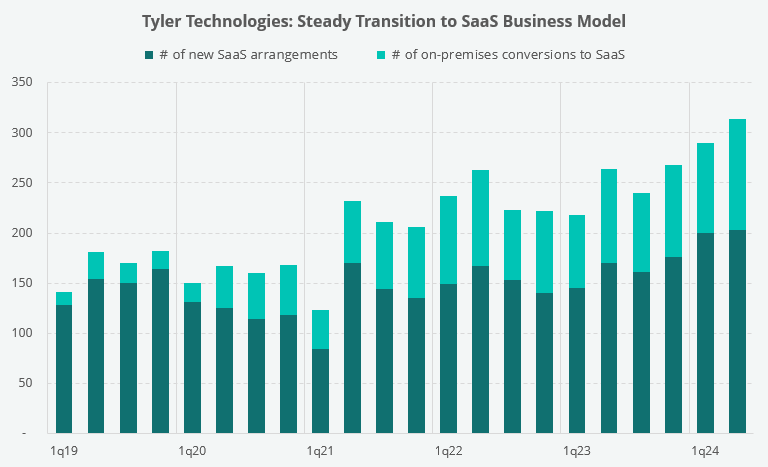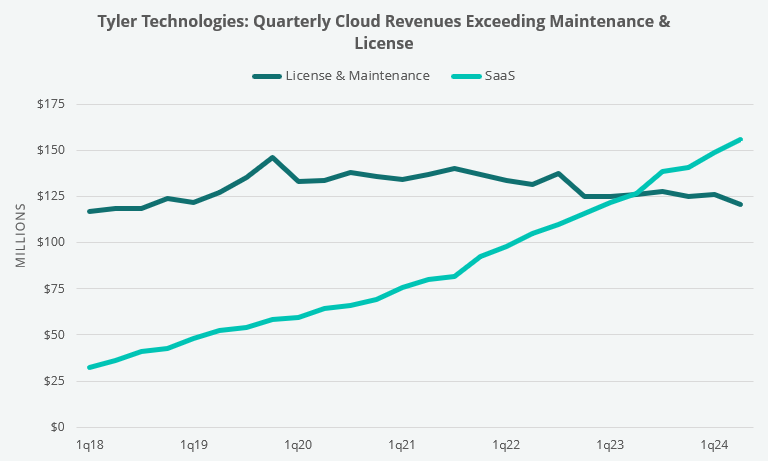Tyler Technologies, based in Plano, TX, is the only public company focused solely on software for state and local governments in North America. Since 1998, Tyler has acquired over 40 software companies. Revenues have grown from $50 million in 1998 and will likely surpass $2 billion at the end of 2024. Cash flows and operating profits have grown at a faster rate over this time frame.
FIRST TRANSFORMATION
Although most of us know Tyler now as a pure software company, it actually started out as a manufacturing and industrial company.
The story begins with Joseph McKinney, a venture capital investor in the 1960s, who used his early financial success to start a company named Saturn Industries. McKinney acquired Tyler Pipe in 1968, a manufacturer of sewage pipes, and changed Saturn’s name to Tyler Corporation. In the ensuing two decades, McKinney used Tyler as a vehicle to acquire a variety of businesses, adhering to the M&A-driven conglomerate style of businesses in vogue during those years. Tyler ultimately hit its first peak in revenues in 1987, reaching $1 billion in sales.
In the late 1980s, McKinney saw private equity companies entering the M&A fray, doing larger and larger deals at larger and larger multiples. However, unlike many of his peers, McKinney had some discipline. Thus, McKinney began to sell most of the businesses he had acquired over the years. By the mid-90s, Tyler had sold 12 businesses and distributed over $400 million to shareholders.
However, the deal-making desire didn’t completely leave McKinney. In 1995, McKinney bought Forest City Auto Parts and Institutional Financing. These both turned out to be awful investments and McKinney resigned as CEO in 1997.
From here, with the help of Louis Waters, who had acquired a 10% position in Tyler, Tyler would sell all vestiges of its past and reallocate the capital into software businesses that served local and municipal governments.
TODAY'S TYLER
Again, today Tyler is the only publicly traded company focused solely on providing software solutions to local and state governments in North America. It is the market leader with just a 6% share in a highly fragmented market worth $35 billion. Furthermore, it is one of the vanishingly few companies that have successfully pivoted entirely from one industry to a completely new industry—from industrial conglomerate to vertical market software. (If anyone knows of other examples of companies who made such a pivot, I would love to hear about it!)
Tyler is now approaching $2 billion in annual revenues after a long and steady march. Over the years, it has acquired many companies, small and large, to round out its capabilities. It has an ERP system (enterprise resource planning), products for almost anything related courts and public safety, health and human services, tax appraisal, outdoor recreation, K-12 education, and many more.
Prior to 2019, Tyler had taken an agnostic approach to building and selling its products, deferring to the preferences of its customers. Historically, as with many software companies, Tyler offered two options to its customers. One was its on-premise option, where Tyler sold a license to its customer to install and use Tyler’s software on computer systems owned and operated by that customer. In the industry vernacular, this is an “on-prem” sales model, as its customers installed and kept the software on their own premises. The second option was for Tyler to install and host the software in datacenters owned/rented by Tyler and then charge its customers on a regular basis for use of the software. Historically, nearly all of Tyler’s customers preferred the on-prem way of doing things.
With the advent of cloud computing services from Amazon, Microsoft, and Google, most software companies have transitioned from on-prem offerings to “SaaS” offerings (i.e., software as a service). This is where the customer rents the software from Tyler who then hosts it in the cloud on someone else’s computers. Tyler then collects a rent on a regular basis. The upside to the customer is they don’t have to worry about investing in expensive hardware or investing in a skilled labor force that maintains the computers and the software. The upside to Tyler is they stand to earn 2x the lifetime revenues with a cloud deal than they’d typically earn with a standard on-prem deal.
Thus, Tyler decided to become a “cloud first” company. They announced a partnership with Amazon Web Services in October 2019 and began their second transformation, from that of an on-prem software company to one with a subscription-based business model.
SECOND TRANSFORMATION
Tyler’s second transformation is now five years underway. We can clearly see that something has been going on as margins have declined from the low 20s to the high teens over the last eight years.

The cause for the decline in margins is Tyler’s transition to a SaaS business model. They’ve been consolidating the many different versions of older products. The company has also been experiencing duplicative costs as they move current customers out of Tyler’s data centers and into the cloud with AWS. Finally, the transition to a SaaS model naturally pressures margins and revenue growth because there are less up-front revenues when a customer signs a SaaS contract with Tyler.
However, we are confident Tyler’s operating margins will trend upwards to the high 20s by 2030. The primary reason is that the headwinds from the cloud transition will be gone by that time. In 2030, most of Tyler’s revenues will be from cloud and SaaS arrangements.
To measure the progress of Tyler’s transition, we track new subscription contracts as a percent of total new contracts. On a dollar value basis and on the basis of absolute number of new customers, the choice has been overwhelmingly for the cloud over the last several years.

Tyler is also flipping hundreds of current on-prem customers to the cloud every quarter. Tyler also just reported two consecutive quarters of more than 200 new SaaS arrangements with customers.

Furthermore, as of a year ago, Tyler’s quarterly revenues from SaaS arrangements have started to exceed the combined revenues from maintenance and license deals. With negligible growth in maintenance revenues ceasing to be a headwind, the tailwind from SaaS arrangements will only increasingly be felt as the company moves forward.

Finally, our last chart shows the long term shift in segment revenues. It’s plain to see the drastic move from maintenance to subscription-based revenues over the last ten years.

SUMMARY
As Tyler stated in its 2023 Investor Day presentation, they have thus far flipped about 15% of its on-prem customers to the cloud. Their goal is to increase that cumulative amount to 75%-85% by the end of 2030.
With its recent 2Q 2024 results confirming the strong trend of more current and new customers choosing the cloud and SaaS offering, we believe Tyler is on track for its audacious, long-term goal of drastically improving gross and operating margins and attaining $1 billion of annual free cash flows by the end of 2030.
Git along, little dogie.
Disclaimers and Notes
The content of this publication is for entertainment and educational purposes only and should not be considered a recommendation to buy or sell any particular security. The opinions expressed herein are those of Douglas Ott in his personal capacity and are subject to change without notice. Consider the investment objectives, risks, and expenses before investing.
This document does not in any way constitute an offer or solicitation of an offer to buy or sell any investment, security, or commodity discussed herein or of any of the affiliates of Andvari.
Investment strategies managed by Andvari Associates LLC, Doug’s employer, may have a position in the securities or assets discussed in any of its writings. Securities mentioned may not be representative of the Andvari's current or future investments. Andvari may re-evaluate its holdings in any mentioned securities and may buy, sell or cover certain positions without notice.
Data sources for all charts come from SEC filings, Koyfin, and other publicly available information.


